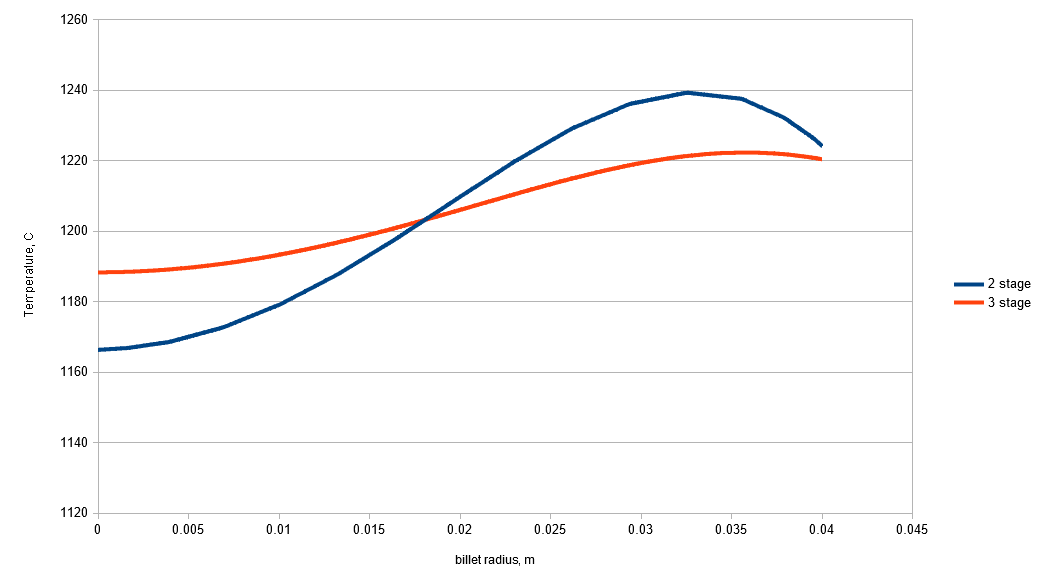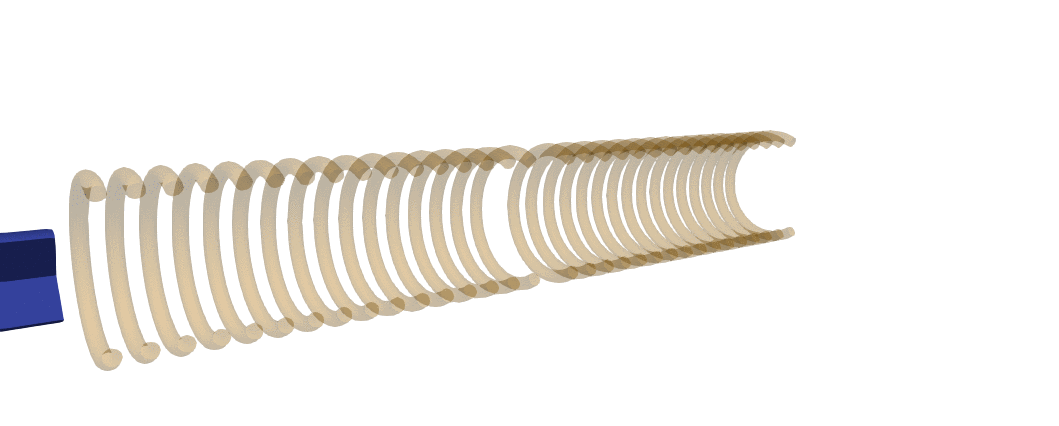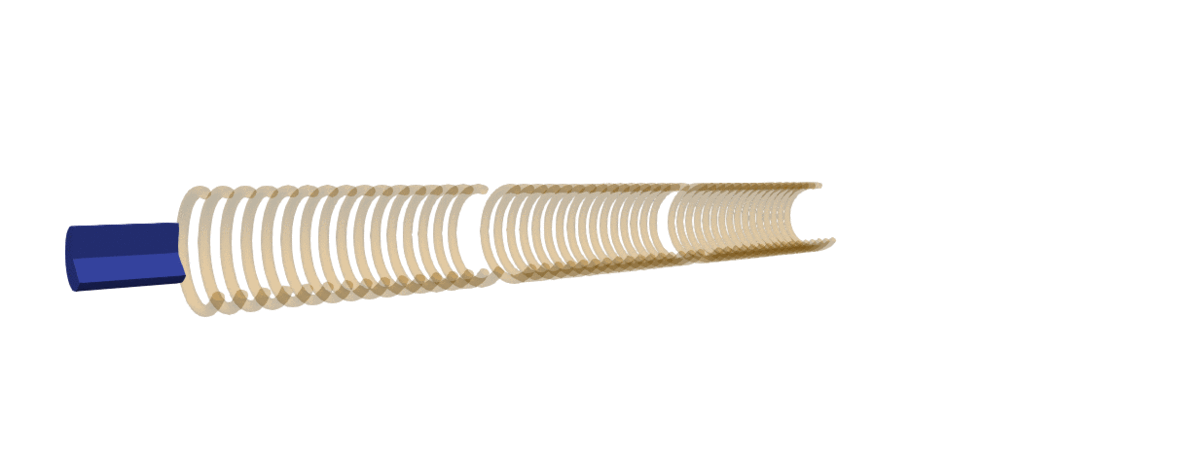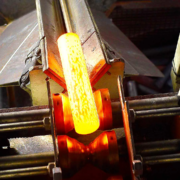Simulation of induction heating of steel billets for forging
Induction is becoming an increasingly popular choice for heating steel billets prior to forging, due to its ability to create high heat intensity quickly and within a billet, which leads to low process-cycle time (high productivity) with repeatable high quality, occupying minimal space on the shop floor.
It is more energy-efficient and inherently more environmentally friendly than most other heat sources for steel billets.

In this article we’d like to demonstrate a simulation example on how to optimise a progressive induction heating system for a steel billet using CENOS, a 3D simulation software, which is focused specifically on induction heating and uses open source components and algorithms, making it affordable for small and medium companies.
CENOS platform is capable of simulating various types of induction heating for forging. It is possible to simulate both static heating and progressive heating where the billet is moved through the coil with constant velocity.
The coil design is also of no limitations – single coil, multi-coil are possible to simulate. Besides the coil it is also possible to simulate any material and frequency.
The functional performance of the software
CENOS is a finite element method based computer-aided engineering desktop software for 2D and 3D physical process simulation & computational modelling of induction heating, induction hardening, brazing, annealing and tempering of steel, aluminium, copper and other materials.
It was designed to be as simple as possible to understand and use even for beginners.
The simulation process consists of three steps:
- Choose the workpiece geometry (from built-in templates or create your own CAD file)
- Define induction heating parameters (frequency, voltage, time, etc.)
- Run 2D or 3D simulation of your choice
At the end, results like temperature and magnetic field are displayed in 3D renderings, plots and more.
Apparent power, induced heat and inductance are logged into an Excel file.
3D Simulation example – comparison of two heating systems
Here, the progressive heating of the billet is simulated, with two systems under consideration – two stage and three stage systems.
- The target for the simulation was to reach 1200 ℃ ± 50 ℃.
To check both systems, user had to create setup for both of them, set physical parameters (material properties, frequency, current etc.) and start the simulation.
After the simulation is done, user have access to different output variables:
- Temperature distribution
- Current density and Joule heat distribution
- Magnetic field lines
- Total, reactive and apparent power
- Inductance of the coil
- Coil current, voltage
- etc.
In our example of billet heating is possible to compare both cases and the output.
| Two stage system | Three stage system | |
|---|---|---|
| Power, kW | 340 | 570 |
| Production rate, kg/h | 830 | 1560 |
| Power per kg, kWh/kg | 0.41 | 0.37 |
It is visible how a three stage system can decrease the power consumption and increase the production rate for this specific case.
It is also possible to plot the distribution of temperature, Joule heat, magnetic field etc. A resulting temperature distribution in the billet across the radius is shown in Figure 1. As can be seen, better temperature homogeneity is obtained in the three stage system.

Figure 1. Temperature distribution along the billet radius at the outlet of the heating system

Figure 2. Temperature distribution in the long billet during scanning (progressive) induction heating.
Figure 2 shows how different systems lead to different temperature distribution. In two stage system, temperature required for forging is reached with shorter coils, thus also with smaller scanning speed. This leads to worse temperature uniformity and smaller production rates.
On the other hand, three stage heater gradually increases the temperature of the billet and the resulting temperature difference between core and surface is smaller.
CENOS users are free to change all the input parameters and assemble the system of any number of stages required for their process.
In case if the same system has to be used for scanning of shorter billets where end effects play a more significant role, it is possible to set up a simulation with moving billet. An example of temperature dynamics in such simulation are shown in GIF images below:

Two stage system

Three stage system
Simulation helps make better decisions for production set-up and planning
As demonstrated in the simulation example it is possible to compare two different systems and get results that make decisions easier thus saving valuable company resources. The scope and variety of different simulations is unlimited, all depends on what problem user wants to solve:
- Heating system design – to optimize induction heating performance, improve product quality, and avoid unpleasant surprises related to subsurface overheating
- The selection of power, frequency, and coil length in induction billet heating applications
- The selection of right forging temperatures for plain carbon and alloy steels to avoid possible damage by incipient melting or overheating.
Training requirements
There is a common misconception that simulation software requires only specially educated (and well paid) simulation engineers, usually hired only for one kind of tasks – simulation. This is definitely true for sophisticated multi-physics simulation software packages. CENOS 3D desktop software keeps focus on induction heating and contains a variety of automated procedures trying to avoid any unnecessary functionality which might confuse inexperienced users.
Using dedicated templates a beginner can run his first induction simulation just under 30 minutes, and become a pro user with any 3D geometry after 1-2 weeks of self-training, guided by CENOS engineers.
Moreover, CENOS offers webinars, customer support, online forum and rich documentation site to help engineers get started.
Hardware & system requirements
Required operating system: Microsoft Windows 7, 8 or 10.
Required hardware: minimum Intel i5 processor (or similar), minimum 16GB of RAM, suggested – 32GB of RAM. Graphics card performance does not play a big role any standard GPU will cope with the visualization.
Additionally the internet connection is required for software license verification only. Offline version can be purchased upon request.


